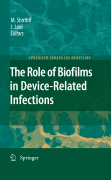
Approximately 60% of all hospital-associated infections, over one million cases per year, are due to biofilms that have formed on indwelling medical devices. Device-related biofilm infections increase hospital stays and add over one billion dollars/year to U.S. hospitalization costs. Since the use and the types of indwelling medical devices commonly used in modern healthcare are continuously expanding, especially with an aging population, the incidence of biofilminfections will also continue to rise. The central problem with microbial biofilm infections of foreign bodies is their propensity to resist clearance by the host immune system and all antimicrobial agents tested to date. In fact, compared to their free floating, planktonic counterparts, microbes within a biofilm are 50 – 500 times more resistant to antimicrobial agents. Therefore, achieving therapeutic and non-lethal dosing regimens within the human host is impossible. Provides the reader with the science and microbiology behind one of the burgeoning increases in infectious disease, indwelling medical device infections
- ISBN: 978-3-540-68113-7
- Editorial: Springer
- Encuadernacion: Cartoné
- Páginas: 275
- Fecha Publicación: 01/11/2008
- Nº Volúmenes: 1
- Idioma: Inglés
